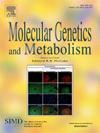Predicting disease-overarching therapeutic approaches for congenital disorders of glycosylation using multi-OMICS
IF 3.5
2区 生物学
Q2 ENDOCRINOLOGY & METABOLISM
引用次数: 0
Abstract
Background
Congenital Disorders of Glycosylation (CDG) are a rapidly expanding group of inherited metabolic diseases caused by defects in glycosylation. Although over 190 genetic defects have been identified, effective treatments remain available for only a few. We hypothesized that integrative analysis of multi-omics datasets from individuals with various CDG could uncover common molecular signatures and highlight shared therapeutic targets.
Methods
We compiled all publicly available RNA sequencing, proteomics and glycoproteomics datasets from patients with PMM2-CDG, ALG1-CDG, SRD5A3-CDG, NGLY1-CDDG, ALG13-CDG and PGM1-CDG, spanning different tissues, including induced cardiomyocytes, human cortical organoids, fibroblasts, and lymphoblasts. Differential expression and glycosylation analyses were performed, followed by Gene Set Enrichment Analysis (GSEA) to identify commonly dysregulated pathways. We then applied the EMUDRA drug prediction algorithm to prioritize candidate compounds capable of reversing these shared molecular signatures.
Results
We identified four glycoproteins with consistent differential glycosylation across all eight glycoproteomics datasets. Six glycosylation sites and glycan structures were recurrently altered across CDG and showed partial correction with treatment. Pathway analysis revealed shared disruptions in autophagy, vesicle trafficking, and mitochondrial function. EMUDRA predicted several repurposable drug classes, including muscle relaxants, antioxidants, beta-adrenergic agonists, antibiotics, and NSAIDs, that could reverse key pathway abnormalities, particularly those involving autophagy and N-glycosylation.
Conclusion
Most dysregulated pathways were shared across CDG, suggesting the potential for common therapeutic strategies. Several candidate drugs targeting these shared abnormalities emerged from integrative analysis and warrant validation in future in vitro studies.
利用多组学预测先天性糖基化疾病的总体治疗方法
先天性糖基化障碍(CDG)是一种迅速扩大的由糖基化缺陷引起的遗传性代谢性疾病。虽然已经确定了190多种遗传缺陷,但有效的治疗方法仍然只有少数。我们假设对来自不同CDG个体的多组学数据集进行整合分析可以发现共同的分子特征并突出共同的治疗靶点。方法:我们收集了来自PMM2-CDG、ALG1-CDG、SRD5A3-CDG、NGLY1-CDDG、ALG13-CDG和PGM1-CDG患者的所有公开的RNA测序、蛋白质组学和糖蛋白组学数据集,涵盖不同的组织,包括诱导心肌细胞、人皮质类器官、成纤维细胞和淋巴细胞。进行差异表达和糖基化分析,然后进行基因集富集分析(GSEA)以确定常见的失调途径。然后,我们应用EMUDRA药物预测算法来优先考虑能够逆转这些共享分子特征的候选化合物。结果在所有8个糖蛋白组学数据集中,我们鉴定出4种糖蛋白具有一致的差异糖基化。六个糖基化位点和聚糖结构在CDG中反复改变,并在治疗中显示出部分纠正。通路分析揭示了自噬、囊泡运输和线粒体功能的共同破坏。EMUDRA预测了几种可重复使用的药物类别,包括肌肉松弛剂,抗氧化剂,β -肾上腺素能激动剂,抗生素和非甾体抗炎药,可以逆转关键通路异常,特别是那些涉及自噬和n -糖基化的异常。结论大多数失调通路在CDG中是共享的,提示有可能有共同的治疗策略。针对这些共同异常的几种候选药物从综合分析中出现,并在未来的体外研究中得到验证。
本文章由计算机程序翻译,如有差异,请以英文原文为准。
求助全文
约1分钟内获得全文
求助全文
来源期刊

Molecular genetics and metabolism
生物-生化与分子生物学
CiteScore
5.90
自引率
7.90%
发文量
621
审稿时长
34 days
期刊介绍:
Molecular Genetics and Metabolism contributes to the understanding of the metabolic and molecular basis of disease. This peer reviewed journal publishes articles describing investigations that use the tools of biochemical genetics and molecular genetics for studies of normal and disease states in humans and animal models.
 求助内容:
求助内容: 应助结果提醒方式:
应助结果提醒方式:


